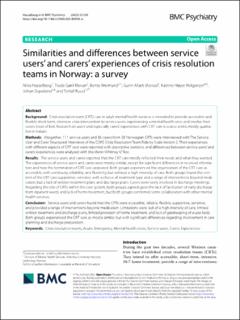| dc.description.abstract | Background Crisis resolution team (CRT) care in adult mental health services is intended to provide accessible and flexible short-term, intensive crisis intervention to service users experiencing a mental health crisis and involve their carers (next of kin). Research on users’ and especially carers’ experiences with CRT care is scarce and is mostly qualitative in nature. Methods Altogether, 111 service users and 86 carers from 28 Norwegian CRTs were interviewed with The Service User and Carer Structured Interviews of the CORE Crisis Resolution Team Fidelity Scale Version 2. Their experiences with different aspects of CRT care were reported with descriptive statistics, and differences between service users’ and carers’ experiences were analyzed with the Mann-Whitney U Test. Results The service users and carers reported that the CRT care mostly reflected their needs and what they wanted. The experiences of service users and carers were mostly similar, except for significant differences in received information and how the termination of CRT care appeared. Both groups experienced the organization of the CRT care as accessible, with continuity, reliability, and flexibility, but without a high intensity of care. Both groups found the content of the CRT care supportive, sensitive, with a choice of treatment type and a range of interventions beyond medication, but a lack of written treatment plans and discharge plans. Carers were rarely involved in discharge meetings. Regarding the role of CRTs within the care system, both groups agreed upon the lack of facilitation of early discharge from inpatient wards and lack of home treatment, but both groups confirmed some collaboration with other mental health services. Conclusion Service users and carers found that the CRTs were accessible, reliable, flexible, supportive, sensitive, and provided a range of interventions beyond medication. Limitations were lack of a high intensity of care, limited written treatment and discharge plans, limited provision of home treatment, and lack of gatekeeping of acute beds. Both groups experienced the CRT care as mostly similar, but with significant differences regarding involvement in care planning and discharge preparation. | en_US |

